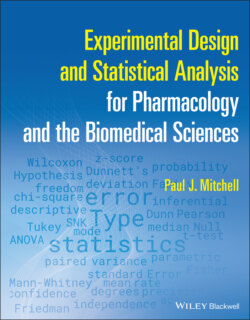Читать книгу Experimental Design and Statistical Analysis for Pharmacology and the Biomedical Sciences - Paul J. Mitchell - Страница 22
3 Numbers; counting and measuring, precision, and accuracy
ОглавлениеWhen we obtain data in our experiments, we either count the occurrence of an event or we make measurements of a specific parameter.
A count can only be a whole number (i.e. an integer), while a measurement may have any number of decimal places depending on either the accuracy of the instrumentation of the equipment used to make the measurement or any subsequent calculation that uses such measurements. So, if we use a typical home room thermometer to measure temperature, then we should be able to observe whole degree Celsius differences in temperature. If we use a laboratory thermometer then, hopefully, we should achieve an accuracy of half a degree Celsius, and accuracy may be further improved to 0.1 of a degree Celsius by using a reasonably priced digital thermometer. However, if we have access to a high‐quality industrial thermometer for use with thermocouples or resistance thermometer probes to measure temperature, then the accuracy may be improved even further. However, no number of decimal places will yield the true temperature as we will always be unsure of what number lies beyond the last digit. Perhaps the best we can hope for, no matter what we are measuring, is to achieve data with the highest level of precision and accuracy available to us.
